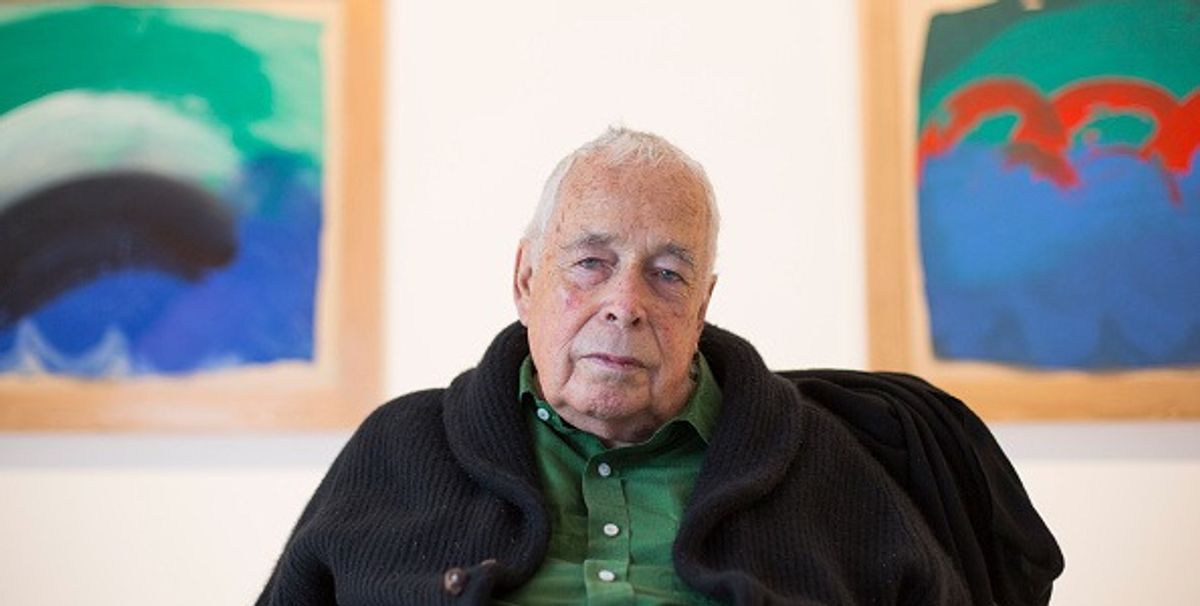The British painter Howard Hodgkin has died at the age of 84. A statement issued by the Tate said that he died peacefully in hospital in London. The Tate’s director Nicholas Serota, who staged exhibitions of Hodgkin’s work at all three museums he has directed, Modern Art Oxford (1976), the Whitechapel Gallery (1985) and Tate Britain (2006), says that Hodgkin was “one of the great artists and colourists of his generation. His sensuous, intense paintings were infused with his love and understanding of late 19th-century French painting, especially Degas, Vuillard and Bonnard, and by his feeling for the heat and colours of India, which he visited on many occasions.”
Hodgkin won the Turner Prize in 1985, the year after an acclaimed show in the British Pavilion at the Venice Biennale, and has exhibited widely and prominently since, including at the Hayward Gallery, the Metropolitan Museum of Art in New York (1995-96) and the Reina Sofía in Madrid in 2007. His paintings may appear abstract at first, but were in fact memorials to recollections. “His characteristic subject, the memory of a meeting or a conversation with a friend, resulted in paintings that radiate the emotions of life: love, anger, vanity, beauty and companionship,” Serota says.
Hodgkin’s work in the 1960s was dominated by witty, highly coloured and patterned pictures of friends in interiors, but from the 1970s onwards, his language grew freer and his subjects broader. Travel became an increasing fixation, and Hodgkin produced major bodies of work in Naples and Venice in particular, arguably catching the melancholic watery beauty of La Serenissima better than any artist since JMW Turner.
But his travels to India prompted his most sustained engagement with place: over five decades, he produced countless poetic evocations of Indian views and experiences, redolent of the landscape, the food, the interiors and textiles of the continent, but also of its heat, even its claustrophobia. On his many visits to India, he amassed an unrivalled collection of Indian paintings which were a lifelong and, as he said, occasionally dangerous passion. Though his paintings used framing devices and high colour, Hodgkin always rejected the idea that they were influenced by his Indian collection. Indeed, his holdings were unusual in that many of the works he owned were monochrome: magnificent drawings of elephants were among the many highlights.
In many ways, Hodgkin’s trajectory as a painter was orthodox: his handling grew gradually looser, his compositions more abstract, and more sparse, with vast areas of the surface left bare. He painted on wood from the late 1960s onwards, because, he said, canvas turned to linoleum when put under the pressure of his layers and revisions, as he strove to complete pictures over several years. When I interviewed him in 2008, he told me that he was spending more time in his studio. “I come in here, often at night, and just look. It often looks as if I don’t do any work at all: it’s not true, of course.” And he was acutely aware that of time running out, investing his later paintings with deeper emotion than ever. “I think it’s the end-of-life kind of feeling: not much time left. The doors are going to shut in a tube train… Which for someone of my age is inevitable, I don’t mean it to sound dramatic. But it’s always in the back of your mind.”
Hodgkin remained a prolific painter and printmaker to the end, with exhibitions last year of new etchings at the Alan Cristea Gallery in London, and new paintings at the Gagosian Gallery in Paris. Gagosian Hong Kong is showing some of his last works until 11 March. And Hodgkin is the subject of two major shows in Britain this year. A show of paintings inspired by India opens at the Hepworth Wakefield on 30 June, and a National Portrait Gallery exhibition, all-too-fittingly called Absent Friends, opens next week.
Simon Wallis of the Hepworth Wakefield described Hodgkin as “one of the most important artists of our time” and added that the gallery was “enormously grateful for Howard's generosity with his time and his enthusiasm. We are proud to be realising an exhibition about the influence of India on his work, a place that he was so passionate about, and from which he drew such inspiration throughout his life.”


